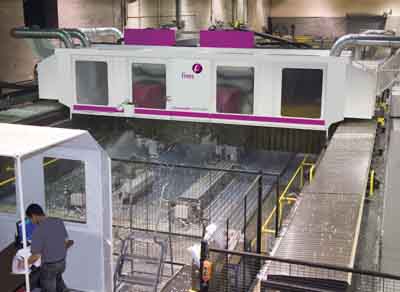
Fives says the new 5-axis, 5-spindle Cincinnati XP aerospace profiler lives up to its name, delivering "X-treme Productivity" in machining of structural aluminum parts. With doubled spindle speeds, greater horsepower and higher feed rates on all axes, the purpose-designed machine delivers 50 to 80 percent faster cycle times than prior models, while cutting multiple parts each cycle.
The XP profiler's modular design utilizes many features incorporated into Cincinnati's record-setting XT titanium profiler. It carries from one to five A/B-axis spindle heads in a traveling-gantry or traveling-table design, allowing it to complete up to five parts per cycle. The rail-type design allows any practical X-axis length for carrying multiple gantries and creating multiple work zones. The new XP profiler is fully compatible with existing Cincinnati gantry profiler installations. It can use existing Cincinnati profiler beds or X-axis rails, or be installed on independent X-axis rails. X-axis length can be expanded anytime in the field with additional 12' (3.66 m) rail segments. Rail-type machines use dual servo planetary gearbox drives on both sides of the X axis. Y-axis drives can be linear-motor or rack-and-pinion driven.
The new high-speed rotary spindle heads are individually supported and independently driven in A/B axes for increased stiffness, accuracy and dynamic performance. Rotary axis feedrates have been increased to 2,400 dpm, more than 400 percent over the prior design, to support higher tool path velocities in 5-axis contouring. This is complemented with matched feedrates of 1000 ipm (25 mpm) on the X/Y/Z axes for consistently higher path velocities, regardless of the direction of cut. The simple, compact spindle head utilizes individual ballscrew drives for the A and B axes, while the 134-hp (100 kW), 18,000-rpm or 114-hp (85 kW) 20,000-rpm spindles outperform A/C type heads in 5-axis processing of plate parts. The ballscrew drives are completely field-serviceable, an advantage over most A/C head designs.
Multiple spindle configurations are available: three spindles with 1 m center distance, three spindles with 2 m center distance, and five spindles with 1 m center distance. There is also a choice of options in CNC controls, scales/encoders, toolchangers, perimeter guarding, spindle probes, video systems, tool-ID systems, spindle enclosures, mist collection systems and other features.
In first-article cutting tests on a machine recently delivered to a Tier One aerospace supplier, the customer machined an upper wing skin panel approximately 31' x 8.85' (9.5 x 2.7 m) with a min/max thickness of 0.062"/0.4" (1.57mm/10.16mm) and tolerance of +0.000"/-0.005" (+0.000/-0.127mm). According to the customer, surface finish was excellent and the part measured within tolerance after checking 2,200 points with a CMM.
Contact Details
Related Glossary Terms
- computer numerical control ( CNC)
computer numerical control ( CNC)
Microprocessor-based controller dedicated to a machine tool that permits the creation or modification of parts. Programmed numerical control activates the machine’s servos and spindle drives and controls the various machining operations. See DNC, direct numerical control; NC, numerical control.
- feed
feed
Rate of change of position of the tool as a whole, relative to the workpiece while cutting.
- inches per minute ( ipm)
inches per minute ( ipm)
Value that refers to how far the workpiece or cutter advances linearly in 1 minute, defined as: ipm = ipt 5 number of effective teeth 5 rpm. Also known as the table feed or machine feed.
- modular design ( modular construction)
modular design ( modular construction)
Manufacturing of a product in subassemblies that permits fast and simple replacement of defective assemblies and tailoring of the product for different purposes. See interchangeable parts.
- stiffness
stiffness
1. Ability of a material or part to resist elastic deflection. 2. The rate of stress with respect to strain; the greater the stress required to produce a given strain, the stiffer the material is said to be. See dynamic stiffness; static stiffness.
- tolerance
tolerance
Minimum and maximum amount a workpiece dimension is allowed to vary from a set standard and still be acceptable.






